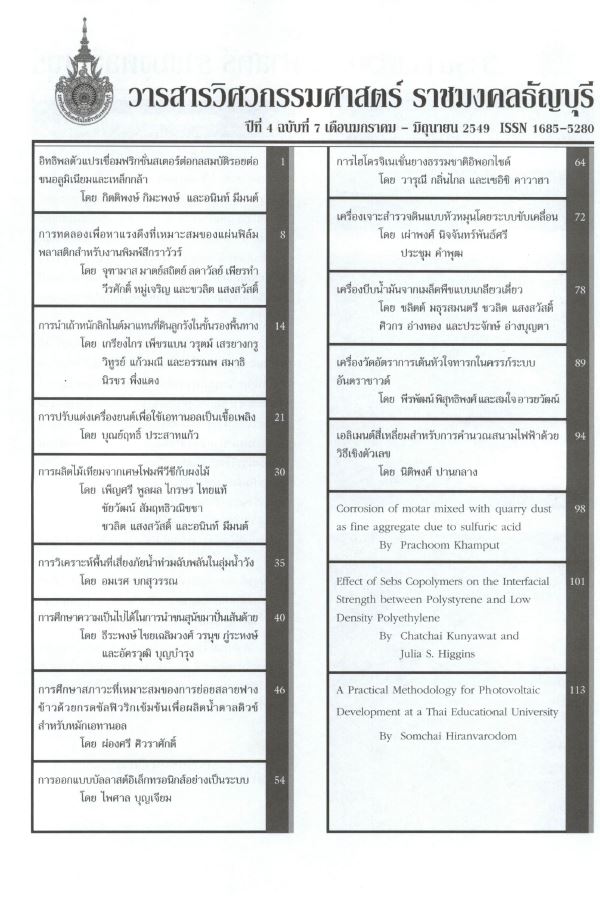อิทธิพลตัวแปรการเชื่อมฟริกชั่นสเตอร์ต่อกลสมบัติรอยต่อชนอลูมิเนียมและเหล็กกล้า
Main Article Content
Abstract
This paper proposes an application of a friction stir welding to butt-weld an aluminum alloy plate to a low carbon steel plate. The effects of pin rotation speed, position of the pin axis and pin diameters on tensile strength and microstructure of the joint were investigated. The main results are as follow s. Butt joint welding of an aluminum alloy plate was easily and success fully achieved. The maximum tensile strength of the joint was about 86% of that of the aluminum alloy base metal. Many fragments of the steel were scattered in the aluminum alloy matrix and a fracture tended to occur along the interface between the fragment and the aluminum matrix. A small amount of intennetallic compounds was formed at the upper part of the steel/aluminum interface while no intennetallic compounds were observed in the middle and the bottom regions of the interface . A small amount of intennetallic compound was also often formed at the interface between the steel fragments and the aluminum matrix. The region s where the intennetallic compounds formed seemed to be fracture path s in a joint.
Article Details
The manuscript, information, content, picture and so forth which were published on Frontiers in engineering innovation research has been a copyright of this journal only. There is not allow anyone or any organize to duplicate all content or some document for unethical publication.
References
[2] T. Watanabe, A. Yoneda, "A study on Ultrasonic Welding of Dissimilar Metals' Q. J, of Japan Welding Society 17-5 (1999) 223-242.
[3] M.J. Rathod and M. Kutsuna, "Joining of Aluminum Alloy 5052 and Low-Carbon Steel by Laser Roll
Welding", Welding J. 83-1 (2004) 16s-26s.
[4] W.M. Thomas and E.D. Nicholas,"Friction Stir Welding for The Transportation Industries',Materials and Design 18 (1997) 269-273.
[5] T. Watanabe, H. Takayama and K. Kimapong,"Joining of Steel to Aluminum Alloy by Inteface activated Adhesion Welding"', Materials Science Forum 426-432 (2003)
[6] K. Yoshikawa and T. Hirano, Numerically Controlled Friction Stir Welding in Layered Dissimilar Metal Materials of Aluminum and Steel", Proceed. Of 3rd Inter. Symp. on Friction Stir Welding, Kobe,Japan, Sept. 27-28, 2001, 1-11.
[7] U.R Kattner and T.B. Massalski, Binary Alloy Phase Diagrams (ASM International, Material Park,OH, 1990) P.147.
[8] P. Ulysse, Three Dimensional Modeling of the Friction Stir Welding Process", Int. J, of Machine Tools&Manu. 42 (2002) 1549-1557.

